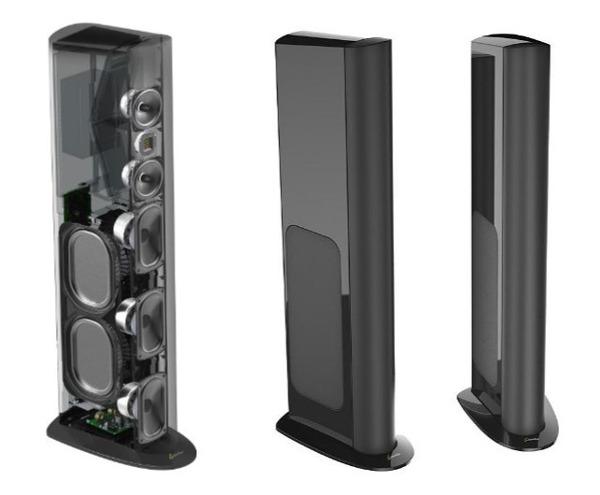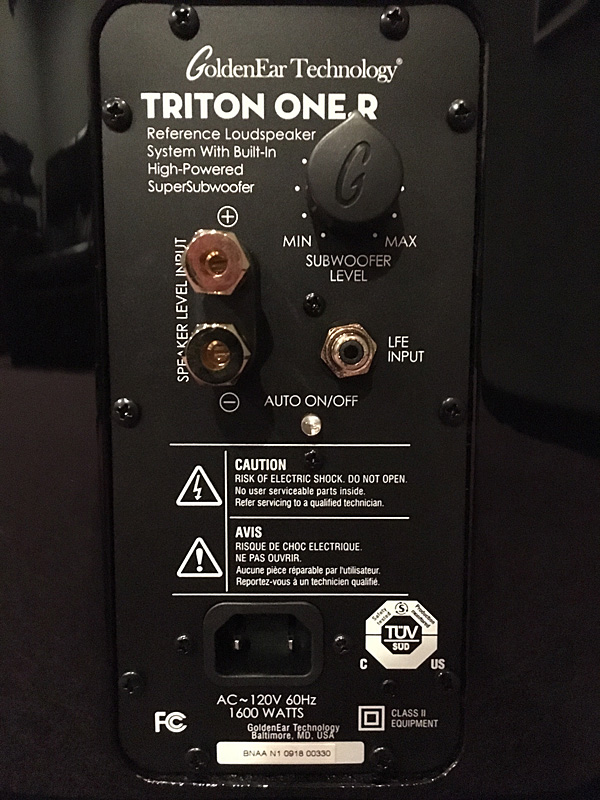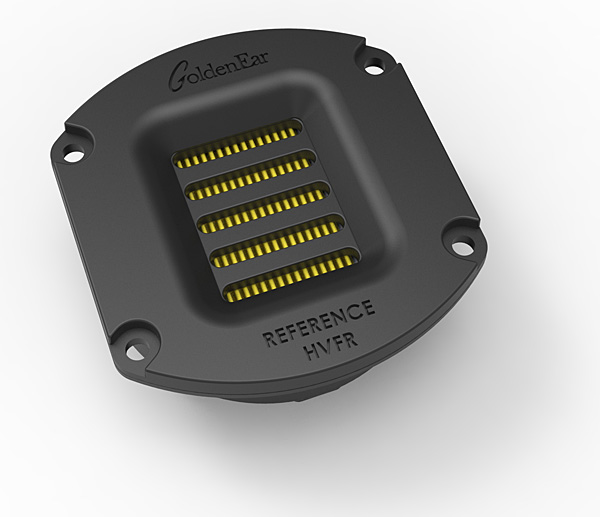I have heard that the Golden Ears have a very narrow sweet spot. If true, this would eliminate them from my consideration as I do not listen in a room with an audience of one (me)- especially as part of a home theater system. Can you please address this?
GoldenEar Technology Triton One.R Loudspeaker Review

AT A GLANCE
Plus
Powerful, full-range sound
Reasonably compact form factor
Excellent value
Minus
Nothing major
THE VERDICT
GoldenEar Technology’s scaled-down version of its Triton Reference delivers similar full-range performance as the company’s flagship speaker but does so at an even more reasonable price.
GoldenEar Technology’s Triton Reference, a model I reviewed in April of last year, was the result of a value-oriented audio brand throwing caution to the wind to produce a cost-no-object loudspeaker. Even so, since we’re dealing with GoldenEar Tech here, the Triton Reference ended up priced at $8,498/pair—not exactly cheap, but well below what you’d pay for the flagship efforts of other speaker brands.
A regular rotation of speakers passes through my doors, but the Triton Reference is the one I was truly sorry to ship back—its powerful, full-range sound and sophisticated cosmetics gave clear indication that co-founders Sandy Gross and Don Givogue were capable of successfully stepping up their game while managing to keep costs in check. For that reason, when GoldenEar Tech asked if I wanted to spend time with its latest creation, a scaled-down $5,998/pair version of their flagship called the Triton One.R, I jumped at the chance.

Standing 54 inches tall, the Triton One.R is four inches shorter than its big brother, and the other dimensions have been pared down as well to create a more compact model than the towering Triton Reference. That said, this is very much a full-range speaker, with frequency response down to 13 Hz according to GoldenEar’s tech specs. And while many other full-range tower speakers require heavy lifting from an attached amplifier, the Reference One.R’s rated 8-ohm impedance and 92 dB sensitivity mean you can use it with even modest integrated amps and receivers. Also like its big brother, the One.R has a built-in subwoofer section—this one with three 5 x 9-inch active bass drivers powered by a 1,600-watt DSP-controlled digital amplifier. The sub’s output is augmented by four 7 x 10-inch passive radiators, two of them mounted on each cabinet side to balance out movement.
The Triton One.R uses the the same High-Velocity Folded Ribbon (HVFR) tweeter as the one found in the Triton Reference. A revamped design with 50 percent more neodymium magnet material than the tweeter units found on earlier speakers from the company, this next-gen HVFR offers improved efficiency and power handling. Rounding out the speaker’s driver complement is a pair of 5.25-inch upper bass/midrange drivers. According to GoldenEar Tech, fine tweaks including a “balanced” crossover configuration, a reworked internal speaker wire topology, and the use of high-quality capacitors all make a contribution to the speaker’s sound quality. Last but not least, the One.R was voiced by the company to mimic the performance of the larger Reference tower.

Whereas the Reference’s large size made it a visually overpowering element in my near-3,000 cubic foot listening room, the One.R’s reduced scale was more to my liking. As with the company’s other tower models, the cabinet tapers in dramatically from back to front, which gives it a slim, streamlined appearance when viewed face-on but also serves to minimize diffraction effects. A very welcome carryover from the Reference is the One.R’s piano black lacquer-coated medite cabinet. This gives the speaker a solid look and is also, according to GoldenEar Tech, “engineered with the goal of making it as non-resonant and inert as possible.”
Features and Setup
The Triton One.R’s lower back features a panel with gold-plated cable connections plus an RCA jack to provide a subwoofer LFE input option when the speaker is used for surround sound applications. There’s also a level knob and an IEC power connection. Four rubber-coated levelling feet are included with each speaker, and there are also metal carpet spikes and discs for use on wooden floors.
Initial positioning of the speakers for best sound in my room was carried out by Sandy Gross himself. While Sandy’s setup favored a tightly angled arrangement for optimal imaging, I later nudged the towers out into a less restrictive formation, one that widened the soundstage a bit but still maintained a solid stereo image. The speakers were placed at a one-foot distance from the room’s back wall and a nine-foot distance from my listening position.
Associated gear used for my main evaluation included a 2 x 150-watt Hegel Music Systems H190 integrated amplifier, an Elac Discovery music server streaming Tidal and stored FLAC files via Roon music management software, a Pioneer BDP-88FD universal disc player, and Nordost Purple Flare speaker cables and interconnects. For the home theater part of my test, I placed the One.R towers in a system consisting of a GoldenEar Technology SuperSat 50C center channel speaker and Triton Two tower speakers for the rear channels, an Anthem AVM-50v surround preamp/processor, a Sunfire Cinema Grand multichannel amplifier, and an Oppo UDP-203 UHD Blu-ray disc player.
- Log in or register to post comments


I had a pair of original Triton 2, and now a set of Triton 1. Sitting about 9 feet apart, 10 feet from my "listening couch" - which seats 3 - the sweet spot is MUCH bigger than the couch. In fact, that's what sold me on the Triton 2 that I bought. When I listened to them in the showroom, I could walk around all over the room, standing, sitting with almost no difference in sound quality. Imaging was kind of holographic - instruments and singers were in the same places, but the perspective on their location changed as you went from one side of the room to the other.
The place where I got the Triton 2 delivered and set up, and when I said "Hey wait, that's a STUPID amount of toe in" they took the time to show me... The holographic imaging was spectacular with a lot of toe in. It went almost completely away, and flattened out, as you removed the toe in. On GoldenEar's web site, they're VERY clear about lots of toe in. When I first heard the Triton 1, Sandy was there, and I think everyone asked him why they were toed in so much. Sometimes my kids will be sweet and help clean, and I can tell you the second I turn on music if they screwed up the toe in.
What I love about these speakers... when we have people over, all through dinner, people are jumping up to scurry from dining room to family room for some song or another. Once at dinner, all conversation suddenly stopped for quite awhile, followed by someone whispering "damn that's really spooky... Muddy Waters is in your family room." And then she snuck over to check.
Our home theater is Triton 1, with a SuperSat 60C center, and Aon 3 for backs. Great for movies. We've laughed as our dogs tracked a movie dog around the room. Spectacular for concert videos.

Awesome and helpful response, Ed. I will keep the Golden Ears on my short list. Sounds like they are as musically involving as their imaging prowess.

Also, I understand that say, the Reference, is not the right solution for every size listening room. Can you give recommended Golden Ear models for various listening room sizes? Mine, for example, is 400 sq ft. And does the height of the room influence this? Thanks

I have a similar sized room with 10 foot ceilings. I have the Triton 3+'s and they fill the room with rich robust sound. I am extremely happy with them and my guests are always impressed. Considering my own budget, the 3+'s are perfect for me. It should be noted, that I do run an SVS SB16 Ultra to fill out the bottom end for music (and of course I crank it up for movies). Per your taste in bass, the 3+'s or larger Tritons may not require this.

Thanks, Fluff. Good and helpful info!

We had Triton 2 in a really large space where we used to live, and the bass level was set to 12 o'clock. When we upgraded to Triton 1, the setting was well below that. In our new place, which has a much lower ceiling, it's turned down even lower. Square feet isn't the right way to think, it's cubic feet.

I love Powered towers for an A/V systems, not so much for Audio only.
I auditioned the original Triton one and the Reference, both excellent speakers for an A/V systems.
My own A/V system consists of DefTech ST-L mains, STS rear towers, side monitors and Myths center channel as well as an additional original Super Cube.
I much enjoy my system for movies, concerts on bluray, and even just for music only.
However, at $6,000 you start getting into direct competition with Speakers designed and engineered with Audiophiles in mind.
Focal, Revel, B&W, PSB, KEF, now Paradigm and others manufacture some somewhat affordable (read starts at $5,000) Main Tower speakers that together with a very good sub will outshine Golden Ear and Def Tech powered towers for music only enjoyment.
Don't get me wrong for those of us who are true A/V enthusiasts, top of the line Powered towers from Golden Ear and Def Tech are a dream come true.
However it is my experience that the far majority of Video enthusiast cap their spending on their speaker system at $5,000 (for most that is 7.1 or 9.2).
Meanwhile Audio enthusiast start at $5,000 for their main speakers (as they usually prefer stereo).
Consequently Golden Ear Triton One R finds itself in the reverse Goldilocks position.
Too expensive for video guys, too shabby for snobby audio guys.
Results, not many sales.
Lucky for me that is exactly how I put together my system.
Floor demo models that were hardly auditioned, and put out to pasture at a dramatic discount to make room for more popular models.

I want to keep my setup simple and listen to 80% movies, and 20% music--although I'd like to listen to music more, and i have the choice between buying the one.r and keeping my sb16-ultra, or buying the reference and selling the sb16-ultra. I like the idea of just two speakers--for a simple clean looking configuration along with a unified sound, but I want the same mids/highs of the reference. My room is only 2000 square feet, and I am running any GE with anthem STR. any suggestions? thanks!






























































